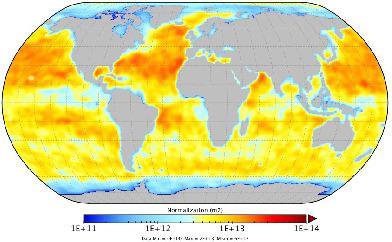当前位置:
X-MOL 学术
›
Q. J. R. Meteorol. Soc.
›
论文详情
Our official English website, www.x-mol.net, welcomes your feedback! (Note: you will need to create a separate account there.)
An evaluation of methods for normalizing diffusion‐based covariance operators in variational data assimilation
Quarterly Journal of the Royal Meteorological Society ( IF 8.9 ) Pub Date : 2020-09-29 , DOI: 10.1002/qj.3918 Anthony T. Weaver 1 , Marcin Chrust 2 , Benjamin Ménétrier 3 , Andrea Piacentini 1
Quarterly Journal of the Royal Meteorological Society ( IF 8.9 ) Pub Date : 2020-09-29 , DOI: 10.1002/qj.3918 Anthony T. Weaver 1 , Marcin Chrust 2 , Benjamin Ménétrier 3 , Andrea Piacentini 1
Affiliation

|
Developing effective ways to model and cycle the background‐error covariance matrix is an active area of research in data assimilation. An important aspect of this problem when using a filter to model the background‐error correlations is the computation of normalization factors to ensure that the diagonal elements of the modelled correlation matrix are all equal to one. Updating the parameters of a flow‐dependent correlation model on each assimilation cycle requires updating the normalization factors, which is costly using traditional methods such as randomization. In this article, we discuss the normalization problem within the context of a diffusion filter‐based covariance model used for background‐error modelling in a variational data assimilation system for the global ocean. We evaluate various methods for estimating normalization factors when the diffusion tensor of the correlation model is derived from an ensemble of ocean states. Our results show that estimates produced using inexpensive methods derived from analytical considerations of the diffusion equation can have significant errors, especially near boundaries. Estimates obtained using randomization with a small sample size (∼100) are more accurate in a globally averaged sense but are noisy and can have unacceptably large errors locally. Next, we focus on the specific problem of accounting for flow‐dependent correlation parameters in the vertical component of the diffusion operator only, which is especially important near the surface for the assimilation of sea surface temperature observations. Remarkably accurate estimates are obtained by approximating the normalization matrix as a separable product of two normalization matrices: one computed using randomization with the horizontal diffusion operator only and the other computed using randomization with the vertical diffusion operator only. If the parameters of the horizontal component of the diffusion operator are static, then only the normalization factors of the flow‐dependent vertical component need to be recomputed on each cycle. This result is of significant practical interest since the vertical diffusion operator employs an inexpensive direct solver and thus can be applied on each cycle with a large random sample to obtain a good approximation of the normalization matrix.
中文翻译:

对变异数据同化中基于扩散的协方差算子进行归一化的方法的评估
开发有效的方法来建模和循环背景误差协方差矩阵是数据同化研究的活跃领域。使用滤波器对背景误差相关性进行建模时,此问题的一个重要方面是计算归一化因子,以确保所建模的相关性矩阵的对角元素均等于1。在每个同化周期上更新依赖于流量的相关模型的参数都需要更新归一化因子,而使用诸如随机化之类的传统方法的成本很高。在本文中,我们将在基于扩散滤波器的协方差模型的背景下讨论归一化问题,该协方差模型用于全球海洋的变分数据同化系统中的背景误差建模。当相关模型的扩散张量是从海洋状态集合中导出时,我们评估各种用于估计归一化因子的方法。我们的结果表明,使用从扩散方程的分析考虑得出的廉价方法得出的估算值可能会产生重大误差,尤其是在边界附近。使用随机样本获得的估计值较小(〜100)在全球平均水平上更准确,但有噪音,在本地可能会出现无法接受的大误差。接下来,我们只关注在扩散算子的垂直分量中考虑与流量相关的相关参数的特定问题,这对于近海表面温度观测的同化特别重要。通过将归一化矩阵近似为两个归一化矩阵的可分离乘积,可以获得非常准确的估计值:一个仅使用水平扩散算子使用随机化计算,而另一个仅使用垂直扩散算子使用随机化计算。如果扩散算子的水平分量的参数是静态的,那么在每个循环中只需要重新计算与流量相关的垂直分量的归一化因子即可。由于垂直扩散算子使用便宜的直接求解器,因此可以用大量随机样本应用于每个循环以获得标准化矩阵的良好近似,因此该结果具有重大的实际意义。
更新日期:2020-09-29
中文翻译:

对变异数据同化中基于扩散的协方差算子进行归一化的方法的评估
开发有效的方法来建模和循环背景误差协方差矩阵是数据同化研究的活跃领域。使用滤波器对背景误差相关性进行建模时,此问题的一个重要方面是计算归一化因子,以确保所建模的相关性矩阵的对角元素均等于1。在每个同化周期上更新依赖于流量的相关模型的参数都需要更新归一化因子,而使用诸如随机化之类的传统方法的成本很高。在本文中,我们将在基于扩散滤波器的协方差模型的背景下讨论归一化问题,该协方差模型用于全球海洋的变分数据同化系统中的背景误差建模。当相关模型的扩散张量是从海洋状态集合中导出时,我们评估各种用于估计归一化因子的方法。我们的结果表明,使用从扩散方程的分析考虑得出的廉价方法得出的估算值可能会产生重大误差,尤其是在边界附近。使用随机样本获得的估计值较小(〜100)在全球平均水平上更准确,但有噪音,在本地可能会出现无法接受的大误差。接下来,我们只关注在扩散算子的垂直分量中考虑与流量相关的相关参数的特定问题,这对于近海表面温度观测的同化特别重要。通过将归一化矩阵近似为两个归一化矩阵的可分离乘积,可以获得非常准确的估计值:一个仅使用水平扩散算子使用随机化计算,而另一个仅使用垂直扩散算子使用随机化计算。如果扩散算子的水平分量的参数是静态的,那么在每个循环中只需要重新计算与流量相关的垂直分量的归一化因子即可。由于垂直扩散算子使用便宜的直接求解器,因此可以用大量随机样本应用于每个循环以获得标准化矩阵的良好近似,因此该结果具有重大的实际意义。



























 京公网安备 11010802027423号
京公网安备 11010802027423号